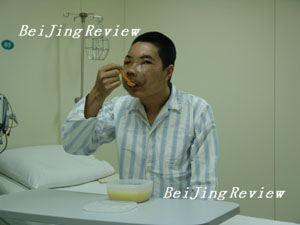
"The biggest post-operation concern is infection and all our measures are targeted at preventing it," Guo said.
To create a totally germ-free environment, Li lives in a sanitized hospital ward through the 100-day recovery period, with the air purified and everything in his room sterilized, including food and the clothing worn by medical staff. Before entering the ward, nurses have to pass five disinfection gates and spend almost half an hour changing clothes. After being fully prepared, the nurses have to stay in the ward for at least eight hours, for every visit increases the risk of infection.
At the moment, eight nurses have been divided into three shifts to take care of Li round the clock, including giving him eye drops every four hours and cleaning his mouth every two hours.
According to a Xinhua report on July 28, the swelling on the transplanted part of Li's face has now almost disappeared, making his face seem more natural. His upper lip now has a small mustache and there is acne on the right part of his face. Guo said all this showed that Li was recovering well.
"Further plastic surgery will be carried out in two or three weeks, to make the right part of his face, his lips and eyes seem more natural," Guo added.
The risk of immunosuppression and rejection is actually the biggest challenge facing Li. To suppress the chronic immunosuppression toward the donor's tissues, doctors said Li must take anti-rejection medicines for the rest of his life.
The lifelong use of anti-rejection medicines not only poses a health risk, but also places a heavy financial burden on Li and his family. For the time being, the cheapest such medicine will cost Li between 1,000 and 2,000 yuan a month, which is almost equal to the monthly income of his whole village.
Doctor Teng Li from the Plastic Surgery Hospital affiliated with the Chinese Academy of Medical Sciences said that because of the cost, the anti-rejection drugs are a double-edged sword for recipients of transplant operations. Yet any virus attack could doom the whole procedure. | 